Books
Crinkleroot's 25 Fish Every Child Should Know
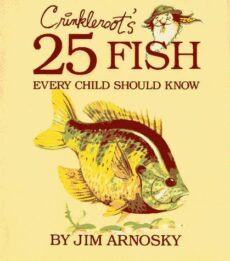
Crinkleroot, a genial mountain man, introduces children to 25 common species of fish in this appealing book. Beautiful watercolor paintings accompany simple text with a unique organizational style (for example, angelfish, seahorse, and flying fish are grouped together because of their unusual shapes). This book provides good exercise for children's observational skills as they learn to look closely and differentiate a variety of fish.
Mister Seahorse
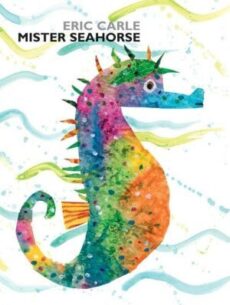
The author creates a world of fascinating underwater creatures, using beautiful colors invoking the ocean. After Mrs. Seahorse lays her eggs in the pouch on Mr. Seahorse's belly, the seahorse father promises to take care of their young until they hatch. As he floats along, he meets other fish fathers similarly caring for their offspring. He also swims past fish that are camouflaged (trumpet fish hiding in reeds, a lionfish behind a coral reef), revealed only when readers turn the clear peek-a-boo pages. A delightful book for young children.
The Magic School Bus Goes Upstream: A Book About Salmon Migration
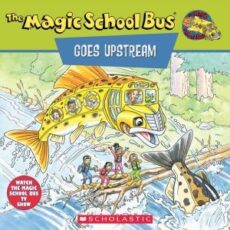
Fishing for food to share at the school's annual fish fry picnic, Ms. Frizzle's class is astonished when the Magic School Bus turns into a giant salmon and takes them all on an incredible journey upstream.
Come Back, Salmon: How a Group of Dedicated Kids Adopted Pigeon Creek and Brought It Back to Life
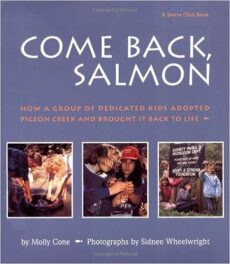
An inspiring true story of young scientists in action, showing how schoolchildren in Everett, Washington, worked with their teachers to clean up Pigeon Creek and reclaim it as a salmon spawning ground. Candid color photos of boys and girls of several ethnic groups, plus a text based on recorded conversations with the kids, lend drama and immediacy; additional scientific facts (e.g., how salmon scales tell the age of the fish; how salmon build a nest or “redd”) appear in boxes. [Kirkus Associates, 1992.]
About Fish: A Guide For Children

Written by an educator and a wildlife biologist, this beautifully illustrated book introduces young children to the diversity of fish species and the basics of how fish swim, breathe, and protect themselves. An afterword offers more details and resources for further learning.
National Audubon Society First Field Guide: Fishes
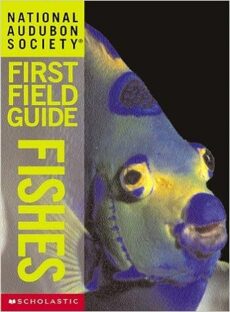
Dive into the spectacular sea! With child-friendly language and vivid photographs, this engaging field guide shows young naturalists how to identify different types of fish, and explains how they breathe, what they eat, and why their bodies are shaped the way they are. Kids will also learn lots of fun fish facts, like how fish build nests, escape predators, and produce electrical currents.
What's It Like to Be a Fish? (Let's-Read-and-Find-Out Science 1)
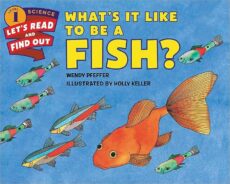
How pet goldfish feed, breathe, swim, and rest in water is the focus of this lively Let's-Read-and-Find-Out Science book. Large, clear, labeled pictures in pen-and-ink, watercolor, and pastel and a simple, informative text explain how scales and slime keep fish healthy, how their sleek shapes help them swim, what it means to be cold-blooded, etc. There's some general information at the beginning about fish in lakes and ponds, and one double-page spread shows them in the sea, but the focus is on caring for a pet goldfish. The final instructions for setting up a goldfish bowl are straightforward and practical. The book design is open and inviting, and Keller's brilliantly colored fish swim through pages washed in aquatic blue and green. [Hazel Rochman]
Sharks
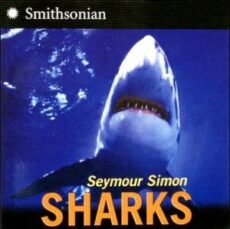
Think sharks are scary and dangerous? Many are gentle and shy! Learn all about sharks with acclaimed science writer Seymour Simon. Amazing full-color photographs and informative text will introduce young learners to the variety, behavior and habitat of these mysterious creatures.
Also in Spanish:
Tiburones
Harper Collins Espanol, 2004
ISBN: 0060564962
DK Eyewitness Books: Fish

Mid-elementary children will love this informative, exciting book! From tropical fish to eels to seahorses, all kinds of fish are discussed with full-color photographs and explanatory text tools appropriate for grades 3-6. Readers can see photos of the jaws of a piranha, an inflated porcupine fish, growth rings on a fish scale, the "stinger" of a sting ray, and much more.
Salmon Forest

Katie and her dad are hiking near a river when Dad announces, “Today we're going to find a story. It's called 'The Salmon Forest'.” In a dialogue between father and daughter, the facts of a salmon's spawning cycle emerge. . . . [T]he text includes lovely sensory descriptions, and the book offers a wider view of the fish's ecosystem than many other books on the subject. In clear, kid-friendly language, Katie and Dad discuss how the salmon and the forest ecosystem form an intricate web of dependency that includes flesh-eating fungi, maggots, and “all the poop” from the animals that feed on salmon. Vibrant watercolors of sun-dappled forest light and shimmering fish bodies add to the sense of atmosphere. A fine demonstration of the web of life for early-elementary science units. A salmon recipe and a glossary are appended. [Gillian Engberg, American Library Association.]
